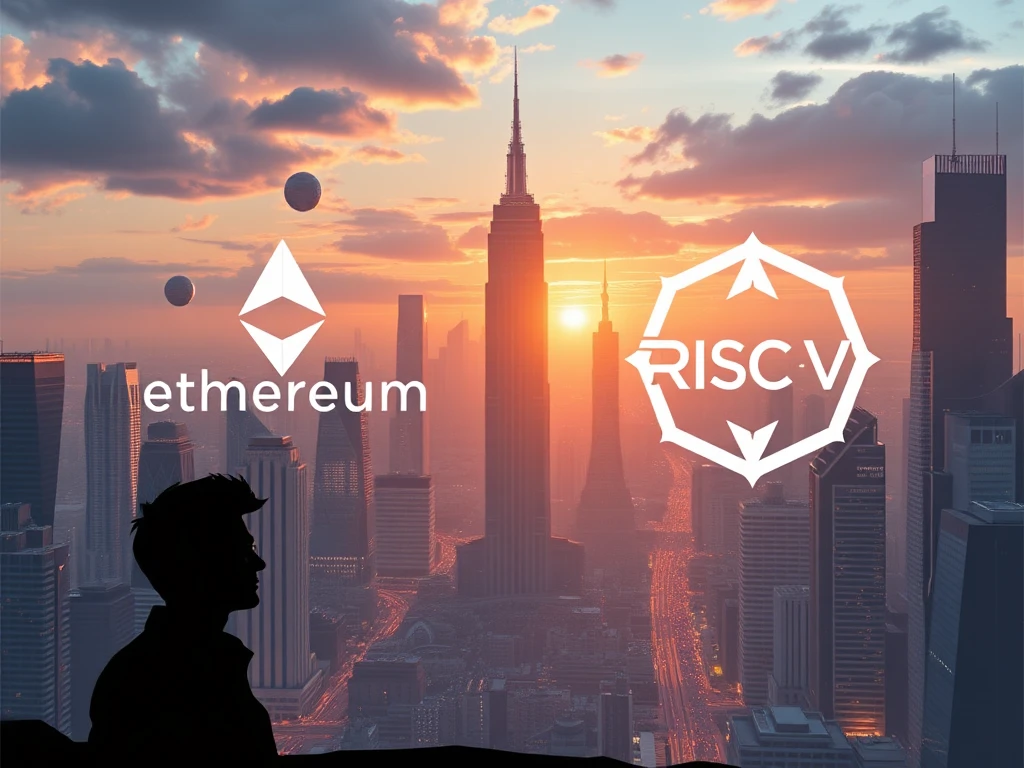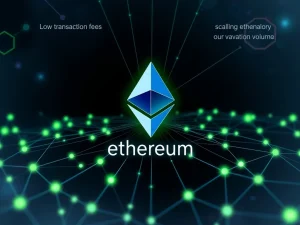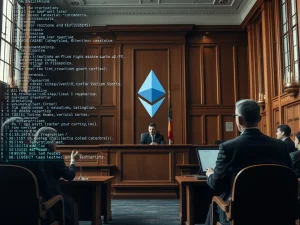Revolutionary Upgrade: Vitalik Buterin’s RISC-V Proposal to Transform Ethereum Efficiency

Is Ethereum on the verge of a revolutionary transformation? Ethereum co-founder Vitalik Buterin has ignited the crypto community with a bold proposal that could dramatically reshape the future of the network. Imagine a faster, more efficient Ethereum – that’s the promise behind Buterin’s suggestion to swap out the current Ethereum Virtual Machine (EVM) language for RISC-V. For anyone invested in the Ethereum ecosystem, or watching the evolution of blockchain technology, this is a development you can’t afford to ignore. Let’s dive into what this groundbreaking proposal means and why it’s generating so much buzz.
Unveiling the RISC-V Vision for Ethereum Virtual Machine
At the heart of Buterin’s proposal is the idea of replacing the Ethereum Virtual Machine (EVM) with RISC-V instruction set architecture. But what exactly does this mean? Think of the EVM as the engine that powers Ethereum, executing smart contracts and driving the network’s operations. It’s a crucial component, but Buterin believes it might be time for an upgrade. RISC-V, on the other hand, is an open-source instruction set architecture that’s gaining traction for its efficiency and flexibility. Buterin argues that adopting RISC-V could unlock significant improvements in Ethereum’s performance, particularly in speed and efficiency.
Key benefits of swapping EVM for RISC-V, as proposed by Buterin:
- Enhanced Efficiency: RISC-V’s architecture is known for its streamlined design, potentially leading to a significant boost in the efficiency of smart contract execution on Ethereum. Buterin suggests potential efficiency gains of up to 100x.
- Improved Scalability: By making the execution layer more efficient, RISC-V could contribute to addressing Ethereum’s ongoing scalability challenges. This is crucial for Ethereum to handle a growing number of transactions and users.
- Competitive Block Production: Buterin believes RISC-V could help maintain competitive block production markets, ensuring the network remains decentralized and robust.
- Zero-Knowledge Proof Efficiency: RISC-V could optimize zero-knowledge functions within the execution layer, which are vital for privacy and scaling solutions.
Addressing Ethereum Scalability Concerns and Competition
The proposal comes at a critical time for Ethereum. While it remains the leading smart contract blockchain, Ethereum faces increasing competition from newer, high-throughput blockchains like Solana and Sui. These “next-generation monolithic blockchains” often boast faster transaction speeds and lower fees, attracting developers and users seeking alternatives. Ethereum scalability has been a long-standing challenge, and while Layer-2 solutions have helped, the base layer still needs improvements to maintain its competitive edge.
Buterin’s proposal directly addresses this need to enhance blockchain efficiency and throughput. He acknowledges that while efforts like “beam chain” hold promise for simplifying the consensus layer, radical changes might be necessary for the execution layer to achieve similar gains. This suggests a proactive approach to ensure Ethereum remains at the forefront of blockchain innovation and doesn’t fall behind in the race for scalability and performance.
The Market Impact: Ethereum Fees and Investor Confidence
The article also highlights some concerning trends for Ethereum. Ethereum network efficiency and scalability concerns have contributed to a decline in base layer transaction fees. Data shows that Ethereum’s blob fees and overall transaction fees have dropped significantly, reaching lows not seen in years. This reduction is partly attributed to users migrating to Layer-2 solutions, which, while beneficial for individual transaction costs, can cannibalize revenue for the Ethereum base layer.
This shift raises questions about the long-term economic sustainability of the Ethereum base layer and its market share. Concerns about revenue generation and the impact of Layer-2 scaling on Ethereum’s dominance may be contributing to pressure on the price of Ether (ETH). The article even mentions potential scenarios where Ether prices could plunge further if investor confidence continues to erode. Buterin’s RISC-V proposal can be seen as a strategic move to revitalize the network, restore confidence, and ensure Ethereum’s long-term viability in a rapidly evolving crypto landscape.
Vitalik Buterin’s Vision: A Bold Move for Ethereum’s Future
Vitalik Buterin‘s proposal to explore RISC-V for the Ethereum Virtual Machine is undoubtedly a bold and forward-thinking move. It signals a willingness to consider radical changes to address fundamental challenges and maintain Ethereum’s leadership in the blockchain space. While the proposal is still in its early stages and requires further research and development, it underscores the ongoing commitment to innovation within the Ethereum community.
In conclusion:
- Buterin’s RISC-V proposal is aimed at significantly improving Ethereum’s speed and efficiency.
- It addresses the need for enhanced Ethereum scalability to compete with next-generation blockchains.
- Potential benefits include up to 100x efficiency gains and optimized zero-knowledge proofs.
- The proposal comes amidst concerns about declining Ethereum base layer fees and market share.
- Implementing RISC-V could be a crucial step in securing Ethereum’s future and restoring investor confidence.
The crypto world is watching closely to see how this proposal unfolds. Will RISC-V be the key to unlocking a new era of blockchain efficiency for Ethereum? Only time will tell, but one thing is clear: Vitalik Buterin continues to push the boundaries of what’s possible in the world of decentralized technology.









